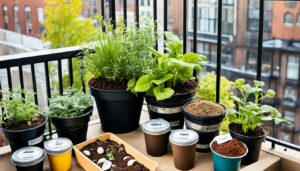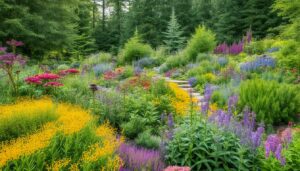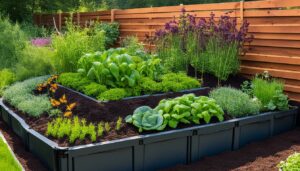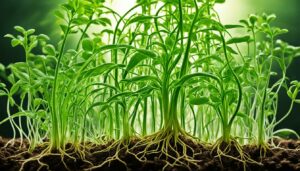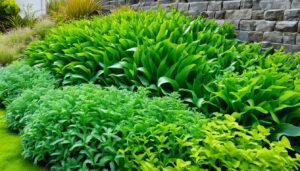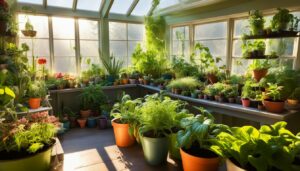“To forget how to dig the earth and to tend the soil is to forget ourselves,” Mahatma Gandhi once reflected. His words encapsulate the essence of biodynamic gardening: a profound return to the roots of cultivation, where every seed planted is a step towards self-awareness and eco-conscious living.
Steeped in the wisdom of fostering holistic gardening practices, biodynamic gardening beckons us to align with the subtle energies of the Earth. It’s more than just planting and harvesting; it’s a philosophical approach that integrates regenerative agriculture, eco-friendly gardening, and self-sustaining garden design. Through reconnecting with the ancient rhythms of the land, we cultivate not only crops but also harmony within nature’s grand tapestry.
As a pinnacle of organic gardening, the biodynamic method encourages us to look beyond the surface, to see our gardens as living, breathing entities linked to the greater cosmos. By tuning in to the natural cycles, from the breathing of Earth to the moon’s phases, this practice becomes more than cultivation—it becomes a symphony of life nurturing life.
Key Takeaways
- Biodynamic gardening is a step towards reconnecting with the Earth and practicing sustainable cultivation.
- It transcends traditional organic gardening, incorporating cosmic influences for holistic plant care.
- A self-sustaining ecosystem is at the heart of biodynamic garden designs.
- These eco-centric methods contribute to regenerative agriculture, enhancing soil vitality and plant health.
- Meticulous attention to lunar patterns and natural cycles is integral to the biodynamic approach.
- By understanding and applying biodynamic principles, gardeners can foster a more profound connection with the environment.
Exploring the Roots of Biodynamic Gardening
The genesis of biodynamic gardening can be traced back to the early 20th century, anchored in the visionary work of philosopher and scientist Rudolf Steiner. His series of lectures in 1924 laid down the foundation for a revolutionary approach to agriculture that would prioritize the health of soil and ecosystem. At a time when industrial farming was becoming increasingly dependent on chemical fertilizers, Steiner advocated for sustainable agricultural methods and the revitalization of rural communities.
Steiner’s insights ignited a movement that blended astrological influence with regenerative agriculture, sparking a collective consciousness towards healing the earth. Advocates of biodynamic gardening grasp the concept of the farm as a single organism, an integrated living system where each element plays a vital role. This holistic view extends to the use of natural materials for soil nurturing and pest control.
- Natural alternatives such as ash and plant-based solutions replace synthetic pesticides.
- Grasses, manure, and powdered quartz are utilized as organic fertilizers, fortifying soil life.
Biodynamic agriculture encourages a cycle of renewal, emphasizing crop diversity and rotation to sustain the land’s vitality. By adopting permaculture techniques, such as companion planting and mulching, this practice endorses an ecological balance that sustains and regenerates life cycles.
| Regenerative Practice | Benefits |
|---|---|
| Nutrient Recycling | Promotes soil fertility and healthy crop yield |
| Open Pollination | Ensures seed sovereignty and genetic diversity |
| Natural Pest Control | Preserves beneficial insect populations |
| Organic Fertilization | Builds long-term soil health without chemicals |
Biodynamic gardening not only revitalizes the land but also forms a symbiotic relationship between the grower and the environment. It’s a testament to the enduring wisdom of Rudolf Steiner and his capacity to inspire generations towards a greener, more mindful form of cultivation.
The legacy of Steiner’s work continues to evolve, and today, the principles of biodynamic farming remain influential in shaping an ethical approach to food production—one that respects nature’s intricate systems and works in harmony with them to produce nourishing, life-sustaining foods.
Principles and Practices of Biodynamic Gardening
The art of biodynamic gardening draws upon ancient wisdom and modern permaculture techniques to cultivate a connection between the gardener, the soil, and the cosmic environment. Integrating principles from regenerative agriculture and holistic gardening practices, this method offers an eco-friendly approach to nurturing landscapes. To understand this rich tapestry of interrelated practices, one must delve into the core elements that define biodynamic gardening.
The Nine Biodynamic Preparations
At the heart of biodynamic gardening lies a suite of biodynamic preparations, unique concoctions that serve as catalysts for soil health improvement and plant growth. Enumerated from 500 to 508, these preparations include cow horns filled with manure or powdered quartz, which are then buried underground in specific seasons to capitalize on cosmic energies. Here is a snapshot of these preparations:
- Preparation 500: Cow horn manure, essential for soil structuring and root development
- Preparation 501: Cow horn silica, to promote plant metabolism and light absorption
- Preparations 502-508: Various herbal compounds that enrich compost with vital forces.
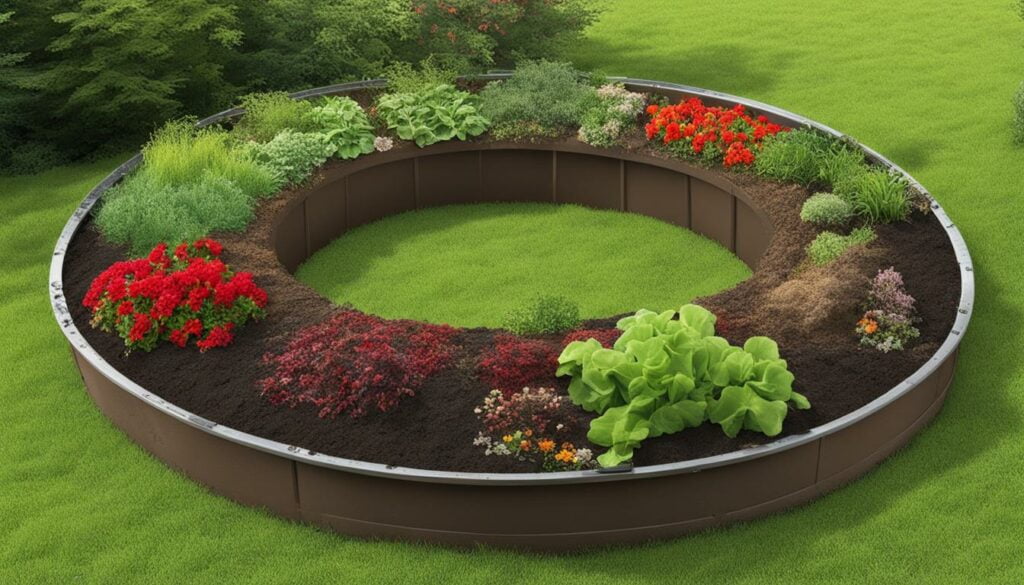
Creating a Self-Sustaining Ecosystem
The ethos of biodynamic farming visualizes a self-regulating ecosystem where all elements are unified. The blend of animal husbandry with organic gardening creates a symphony that sustains itself — livestock nourish the land, which in turn feeds the crops. This perennial cycle minimizes waste and amplifies the resilience of the land, making it a prime example of eco-friendly gardening in action.
Moon Phases and Planting Cycles
Guided by the rhythmic dance of lunar phases, biodynamic gardening aligns sowing and harvesting activities with celestial movements. By attuning to the moon’s influence on moisture in soil and plants, holistic gardening practices meld with astrological insights to map out an optimal agricultural calendar. Asserting a profound impact on growth, moon phases become a trusted partner for timing the tender acts of planting and pruning.
Biodynamic gardening, holistic gardening practices, sustainable agricultural met
At the heart of biodynamic gardening lies a commitment to foster a symbiotic relationship with nature, where the cycles of the earth and the gardener’s touch converge harmoniously. This practice leverages sustainable agricultural methods that adhere to the rhythm of the natural world while ensuring productivity and wellness for both soil and plant life. Image of holistic gardening aligns with the principles of regenerative agriculture and permaculture techniques, wherein every action is thoughtfully considered to minimize environmental impact and boost the garden’s innate resilience.
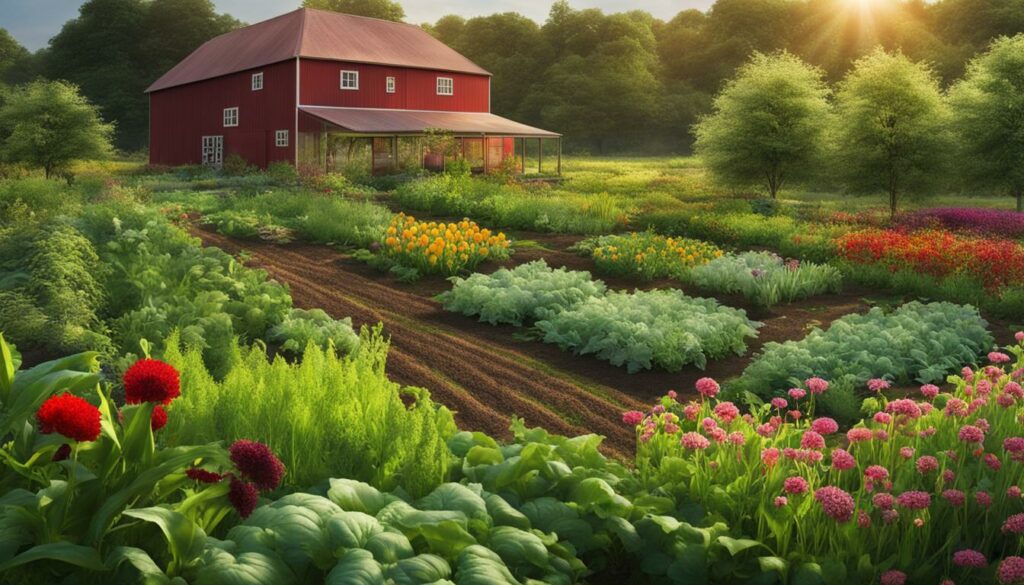
Through mindful engagement with the land, biodynamic cultivators practice what could be termed as “slow gardening,” embracing periods of observation and reflection. This holistic gardening practice encourages a beautiful tapestry of flora and fauna to thrive, shaped and nurtured by both human hands and the subtle forces of mother nature. From composting to crop rotation, the tools and techniques employed in biodynamic gardens intertwine to create a living, breathing ecosystem brimming with life and sustained by its own cycles and processes.
| Principle | Application in Biodynamic Gardening | Benefits |
|---|---|---|
| Biodiversity | Integrating a variety of species in plantings | Promotes a resilient ecosystem and balances pests naturally |
| Soil Health | Utilizing composts and natural preparations | Enhances soil fertility and structure for optimal plant growth |
| Recycling Nutrients | Composting plant and animal waste | Reduces waste and returns nutrients back into the earth |
| Water Conservation | Employing water-wise irrigation practices | Saves water resources and respects the natural water cycles |
This gentle approach to cultivation not only benefits the environment but also elevates our connection to the land, allowing us to grow food and flora that are not only sustainable but also full of vitality. The implementation of permaculture techniques ensures that every garden is a reflection of the delicate balance of life, capable of regenerating itself and providing nourishment for generations to come. It is an exquisite reflection of what can be achieved when we align our gardening practices with the insightful principles of regenerative agriculture.
Implementing a Biodynamic Calendar in Gardening
For enthusiasts of organic gardening, integrating a biodynamic calendar into routine gardening practices isn’t just beneficial; it’s transformative. This agricultural guide deeply respects the intricate bond between celestial dynamics and terrestrial growing cycles. By considering the ebb and flow of moon phases and other astronomical events, the biodynamic calendar provides gardeners with a detailed guide for sowing seeds, transplanting seedlings, and harvesting crops at moments when Earth’s energy fields are most receptive to agricultural activities.
The utilization of a planting calendar rooted in biodynamic principles doesn’t only invoke timely planting but also accentuates the right moments for applying specialized preparations. For instance, the calendar may indicate under a waxing moon the perfect time to enrich the soil with horn manure, a fundamental component of biodynamic agriculture, to maximize its effectiveness.
- Identify the best days for planting root, leaf, flower, and fruit crops
- Understand optimal times for pruning to enhance growth and yield
- Determine advantageous periods for applying biodynamic preparations
Embracing such a calendar encourages gardeners to sync their activities with nature’s rhythm, resulting in a harmonious and vibrant garden ecosystem. So, whether you’re a seasoned gardener or a novice in the art of sustainable agriculture, consider the biodynamic calendar your ally in the pursuit of a flourishing organic garden.
Biodynamic Composting Techniques for Soil Health Improvement
Delving into the heart of eco-friendly gardening, the essence of soil health improvement lies in the meticulous process of biodynamic composting. Harnessing regenerative agriculture and permaculture techniques, gardeners transform everyday waste into a lifeline for their gardens. This method bridges the gap between the simplicity of organic compost and the sophisticated principles of biodynamic practices, thereby taking eco-consciousness to the next level.
Essential Elements for a Nutrient-rich Compost
The genesis of any effective compost lies in its ingredients. Biodynamic composting is unique, utilizing a mixture of natural waste and specialized preparations that contribute to a nutrient-dense final product. Here is a table outlining the key components required to fortify a compost blend that heralds eco-friendly gardening and fosters soil health improvement:
| Component | Benefits | Source |
|---|---|---|
| Animal Manure | Rich in nitrogen and acts as a soil conditioner | Livestock reared within the farming system |
| Biodynamic Preparations | Infuse compost with vital forces that stimulate root growth and enhance soil structure | Plant-based preparations made on-site, adhering to biodynamic methods |
| Garden Waste | Provides bulk and aids in aeration | Crop residues and pruning from the garden itself |
Tuning into Natural Cycles for Waste Transformation
True to the principles of permaculture techniques and regenerative agriculture, biodynamic composting is not just about combining materials but also about aligning with the Earth’s rhythm. This waste transformation is an art form that weaves together time-honored wisdom with natural cycles to create a thriving habitat for microorganisms essential for a high-performing compost. The beauty of this cycle comes alive as waste material metamorphoses into a cornerstone of garden vitality.
The following visual illustrates the transformative power of biodynamic composting as it converts organic waste into garden gold, improving soil health and ushering a new era of sustainability within cultivation practices.
Conclusion
As we draw the threads of holistic gardening practices to a close, it is evident that biodynamic gardening offers more than sustainable agricultural methods; it provides a profound connection to the living tapestry of our environment. By fostering regenerative agriculture and permaculture techniques, this form of organic gardening invites us to harmonize with the inherent rhythms of nature. The practice empowers us to cultivate a vibrant, healthy ecosystem that extends its bounty from the soil to the soul, yielding crops that are as rich in nutrients as they are in taste.
Embracing the Rhythms of Nature
The journey through biodynamic gardening has illuminated the importance of tuning into nature’s cycles and leveraging them to enhance every aspect of plant and soil health. The resilience of such a system against common adversaries like pests and diseases stands as a testament to the robustness of working with, rather than against, the natural world. By intertwining cosmic awareness with terrestrial stewardship, we unlock a level of synergy that results in produce with unparalleled flavor and nutritional content.
From Novice Gardener to Biodynamic Expert
The growth of biodynamic gardening practices has paved the way for resources that are instrumental in guiding both fledgling and skilled gardeners down a path of ecological enlightenment. With access to a thriving community, comprehensive learning materials, and detailed planting calendars, anyone can transition from a novice gardener to a well-versed expert in biodynamic methods. This journey enriches not just the land, but indeed, the very essence of our connection to the world around us, creating a harmonious oasis where both humans and nature can thrive in radiant unity.



